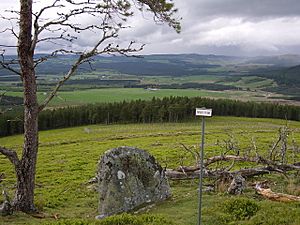Battle of Cromdale facts for kids
Quick facts for kids Battle of Cromdale |
|||||||
|---|---|---|---|---|---|---|---|
| Part of the Jacobite rising of 1689 | |||||||
 The Piper's Stone, a boulder upon which a mortally wounded Jacobite piper played music to encourage his comrades |
|||||||
|
|||||||
| Belligerents | |||||||
| Commanders and leaders | |||||||
| Strength | |||||||
| Unknown | 800 | ||||||
| Casualties and losses | |||||||
| ~100 killed | 400 killed | ||||||
| Designated | 30 November 2011 | ||||||
| Reference no. | BTL20 | ||||||
The Battle of Cromdale was a fight that happened on April 30 and May 1, 1690. It took place at a spot called the Haughs of Cromdale. This area is a hillside near the village of Cromdale in Scotland.
Today, this battlefield is a protected site. It is part of the Inventory of Historic Battlefields in Scotland. This means it is an important historical place.
What Led to the Battle?
Jacobites After a Big Defeat
In 1689, the Jacobite forces lost a major battle at Dunkeld. After this defeat, the Highland clans were feeling down. Many fighters went back to their homes.
Sir Ewen Cameron took charge of the remaining army. He and other Jacobite leaders asked King James for help. They needed more supplies and support in Scotland.
King James Sends Help
King James was busy preparing for a possible invasion of Ireland. But he still sent aid to his Scottish supporters. He sent clothes, weapons, and food.
He also sent officers from Ireland to Scotland. One of these was Major-General Thomas Buchan. King James made Buchan the new leader of the Jacobite forces in Scotland.
Planning the Next Steps
When Buchan arrived, the clan chiefs met at Keppoch. They needed to decide what to do next. Some clans wanted to give up and make peace with the government.
But Sir Ewen Cameron disagreed. Everyone at the meeting finally decided to keep fighting. However, they agreed to wait until spring farm work was done.
Jacobite Army on the Move
They decided to gather their main army later. For now, 1,200 foot soldiers would go with Buchan. Their job was to weaken the enemy's positions.
General Buchan marched his men through Badenoch. He planned to go down Speyside into the Duke of Gordon's area. He hoped to get more fighters there.
A Smaller Force at Cromdale
However, many of Buchan's soldiers left his army. His force shrank to only 800 men. His Scottish officers told him not to go past Culnakill.
But Buchan ignored their advice. He marched his smaller army down the Spey River. They camped at Cromdale on the last day of April.
The Battle Begins
Government Forces Arrive
Near Grantown-on-Spey, Buchan's men met a larger government army. This army was led by Sir Thomas Livingstone. Livingstone was the commander of the Inverness army.
Livingstone and his men approached from the other side of the Spey River. The Jacobite forces saw them and started to retreat.
A Brief Fight and Fog
Livingstone's cavalry (soldiers on horseback) crossed the river. They caught up with the Jacobites. The Jacobites briefly tried to fight back at the bottom of Cromdale hill.
Then, a thick fog rolled down the mountain. It covered the Jacobite soldiers, who were outnumbered. Because of the fog, Livingstone had to stop chasing them.
Counting the Losses
Reports say that the Highlanders (Jacobites) lost about 400 men. These men were either killed or captured. Livingstone's government forces had fewer losses. Some reports say they lost no one, while others say up to 100 were killed.
A Second Small Fight
About 100 Jacobite men had separated from the main group. They crossed the Spey River the next day. Livingstone's men chased them.
They were caught and scattered on the moor of Granish near Aviemore. Some of them were killed there. They also tried to take over the castle of Lochinclan. But the castle owner and his tenants fought them off.
What Happened After?
The End of the Rebellion
The defeat at Cromdale mostly ended the Jacobite rebellion in Scotland. Even so, Jacobite supporters tried to make it sound like a victory.
They wrote a popular song called The Haughs of Cromdale. This song helped spread their viewpoint. It is listed in James Hogg's Jacobite Reliques as song number 2.
A Song of Old Heroes
The last part of the song says:
The loyal Stuarts, with Montrose,
So boldly set upon their foes,
And brought them down with Highland blows
Upon the Haughs of Cromdale.
Of twenty-thousand Cromwell's men,
a thousand fled to Aberdeen,
The rest of them lie on the plain,
They're on the Haughs of Cromdale.
Of twenty-thousand of Cromwell's men,
a-thousand fled to Aberdeen,
The rest of them lie on the plain,
They're on the Haughs of Cromdale.
It's interesting that the song mentions James Graham, 1st Marquess of Montrose. He was a hero, but he actually died 40 years before this battle! The song's tune is still popular today. Pipe bands often play it.

